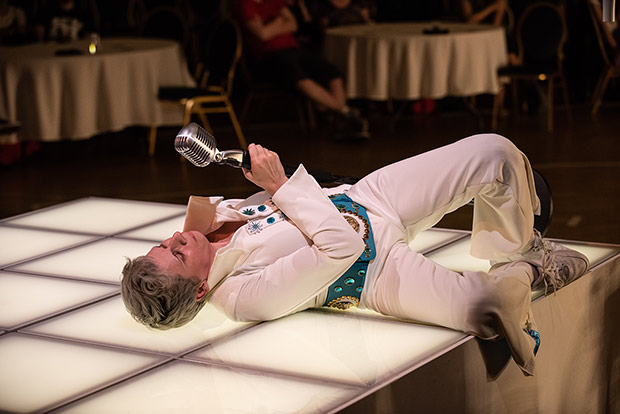
© Hugo Glendinning. (Click image for larger version)
Claire Cunningham’s Thank You Very Much can next be seen at Glasgow’s Couper Institute from 31 Oct – 3 Nov 2019. But do keep an eye on Cunningham’s website for more touring announcements.
Claire Cunningham’s new work Thank You Very Much, which recently opened Manchester’s International Festival, is inspired by the world of tribute artists and particularly those who have dedicated themselves to the impersonation of Elvis Presley. The work is performed and choreographed by an ensemble of leading disabled performers – Dan Daw, Tanja Erhart and Vicky Malin – who have worked closely with professional Elvis tribute artists and have learnt not only about his trademark steps and physicality but also about his quizzical identity as well as the art of impersonation.
However, Thank You Very Much is not an impersonation performance of the King. Cunningham, on her quest to reject reductive expectations of the disabled body and investigate society’s ideas about normality and how bodies are trained to achieve it, focuses on Elvis’s more controversial identity traits and ‘fractured’ dance aesthetic. As an artist who engages with intersectional identity politics and the potential of the disabled body to confront aesthetics of normality she draws links between the icon’s disruptive characteristics and those of the disabled dancer.

© Peter Dibdin. (Click image for larger version)
When I talked to her the work was still being made and Cunningham was cautious about saying too much about it, we did discuss her fascination with tribute artists and why she was exploring Elvis from the perspective of crip-aesthetics – visual and conceptual elements that constitute a distinct disability arts practice.
Cunningham has been an Elvis fan since the age of 17 – falling in love with not only his voice but also his unusual dance moves. From her perspective, of a disabled artist, she found resonance with the language of his body – his twisted ankles, the “broken lines” of his limbs as he performed to his songs, his off-balance positioning. His jaunty, out of control movements style and his famous ‘jelly legs’ which revealed an intriguing misperception of what limbs should be doing in space were all rich sources of inspiration for Cunningham. From a crip-aesthetic, his out of control, unstable body was fascinating. She also wanted to try and capture the expectations that society has about what a celebrity body should do in space and what happens when they don’t conform. Elvis was ridiculed for his weight gain towards the end of this career at a time when very few other men were.
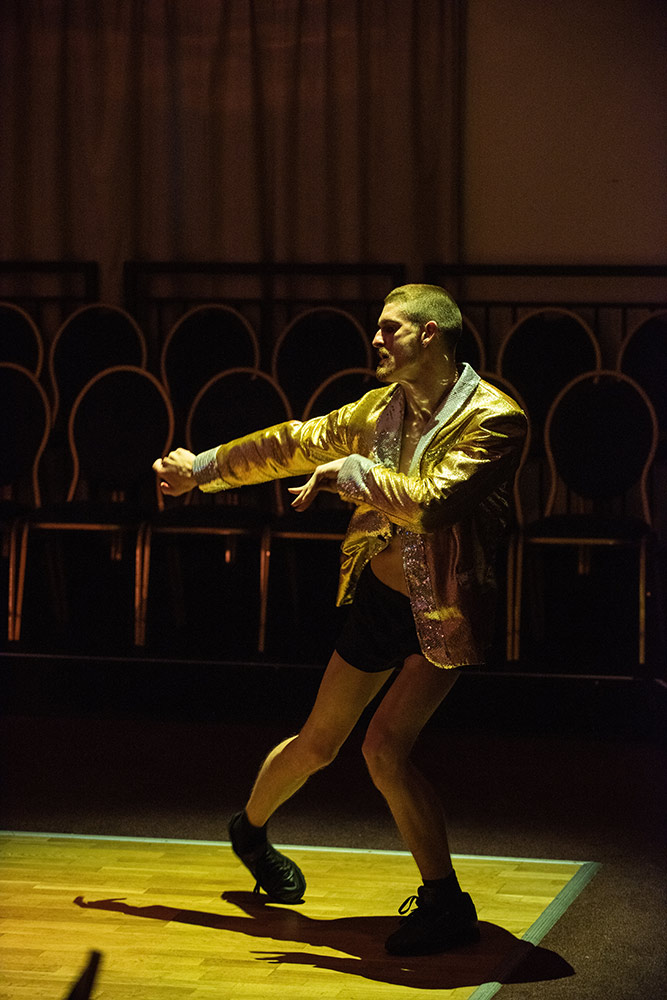
© Hugo Glendinning. (Click image for larger version)
Cunningham was also intrigued about why he was perceived as both controversial and provocative amongst certain sectors of American society, namely the ultra-Christian white community. People criticised him for being dangerous and threatening because he was performing work that seemed to embrace some of the music and dance traditions of Afro-Americans. She questions how he became a spectacle to both fans and enemies through not just his music but his flamboyant dress-sense and unconventional choreography which also prompted questions about queerness. Although most people associate Elvis with hyper masculinity in his later years, when he was younger he adopted a look through his hair style, pink shirts, white satin, sparkly trousers, make-up and jewellery which for some in retrospect aligned with queer. All of these aspects spoke to Cunningham about disability, its unwanted spectatorship and transgressive acts.
In order to understand the movement, Cunningham and her dancers were taught by four different tribute artists each with their individual perspectives on the act of imitation. Impersonation and the pursuit of becoming someone else (famous) also drew parallels for Cunningham with the disabled body and disabled people’s pressure to become an ‘ideal’ body through, for example, surgery or physiotherapy. But Cunningham explains that the experience of working with these tribute artists was about much more than just learning how to move like Elvis. What she was interested in was how people connect to a person with whom they presume they have nothing in common. Elvis became the excuse of why they were all in the room but the focus was more about the connections they made with each different tribute artist. For Thank You Very Much, the dancers convey their different interpretations of their experiences working with these impersonators through text, singing and movement, if with little in the way of conventional dance structures.
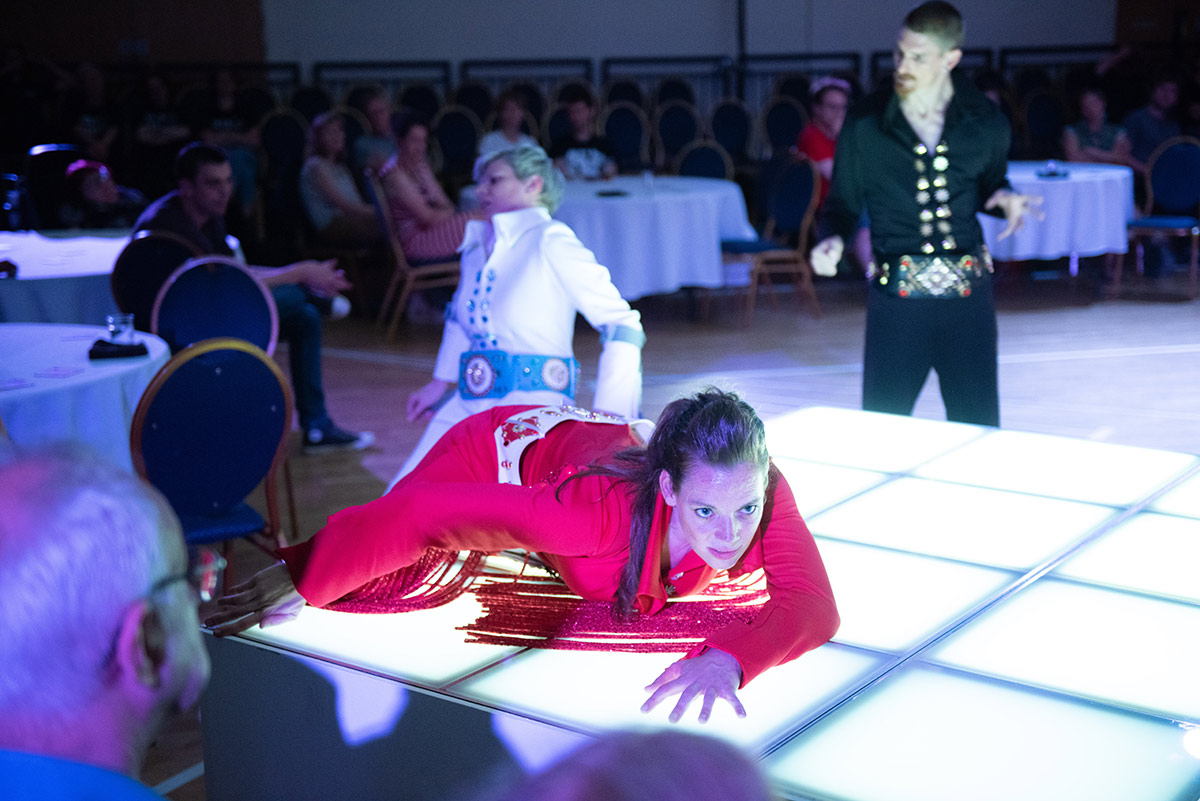
© Hugo Glendinning. (Click image for larger version)
However, the dancers do tap into less well-known movement territory as well as the iconic Elvis moves which Cunningham explains mirrors the variety within his repertoire and how it constantly changed during his career. During the 70’s Elvis’s physicality movement was informed by Karate (he was a black belt) and incorporated a focus on the upper body while he was singing, while later on he hardly moved at all.
When I asked her if her relationship to the King had changed through her intensive research, she replies that it has only increased her respect and admiration for him. She points out that while his songs often contained misogynistic lyrics, while he appropriated Afro-American music and was a cis-gendered heterosexual icon, she can still appreciate him as a singer and performer while acknowledging his failings; a sentiment shared by his massive global and identity diverse fan base. She praises him for how he was one of very few artists who was identified by the way he moved and is hopeful that audiences will learn something new about him… as well as about societal perspectives on disability.







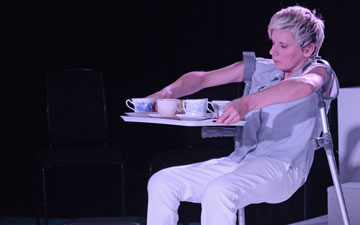


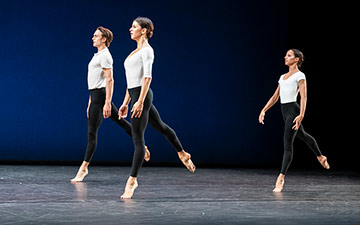

You must be logged in to post a comment.